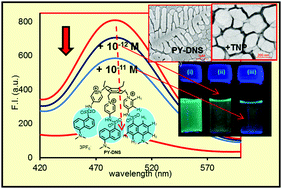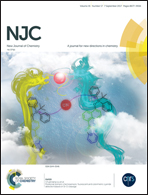Dynamic fluorescence quenching by 2,4,6-trinitrophenol in the voids of an aggregation induced emission based fluorescent probe†
Abstract
We have designed a pyridinium-dansyl conjugate based three dimensional molecular probe PY-DNS, where the TNP anion places itself closer to the dansyl fluorophore owing to its decreased cavity length, as revealed by the DFT optimized structure. PY-DNS undergoes aggregation induced emission in a poor solvent medium like water and has excellent fluorescence efficiency (Φ = 0.71). PY-DNS undergoes dynamic fluorescence quenching with TNP in sub-micromolar amounts, as observed from the increase in the life-time of PY-DNS from 0.73 ns to 1.45 ns in the presence of TNP. This is in contrast to the static fluorescence quenching phenomenon reported in the literature for the detection of TNP, especially at sub-micromolar concentrations. PY-DNS elicits a linear change in fluorescence quenching over eight orders of concentration of TNP (10−13–10−5 M), which is the largest linear range reported for the detection of TNP in the literature. PY-DNS can detect a concentration of TNP as low as 10−13 M in aqueous medium and 137 fg cm−2 of TNP in the solid state.



 Please wait while we load your content...
Please wait while we load your content...